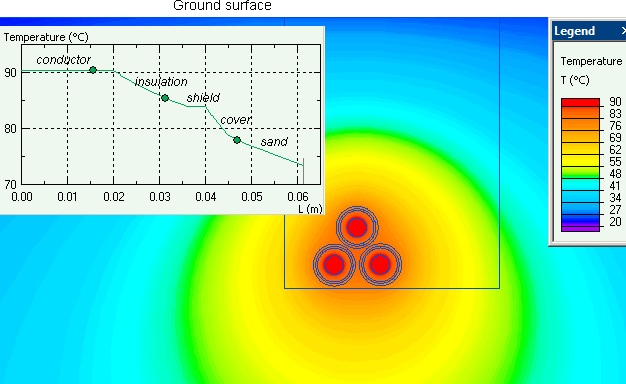High voltage three phase cable ampacity
QuickField simulation example
High voltage 3-phase cable laid in trefoil formation underground.
Problem Type
Plane-parallel multiphysics problem of AC magnetics coupled to Heat Transfer.
Geometry
Given
The cable system consists of 3 single core cables. Cable line length is 1 km. Shields are ground-connected on both ends.
Current I = 1 kA (RMS), frequency f = 60 Hz.
Air temperature T0 = +20°C, convection coefficient α = 10 W/K*m².

Problem:
Currents in the cable produce the power losses, which heat the cable. Cable ampacity is the electric current value, which leads to the maximal allowable temperature of the conductor. Cable ampacity calculation therefore requires simulation of the power losses and temperature distribution for the given value of the electric current.
In this example we determine the losses and temperature distribution for the given current. Then, by increasing or decreasing the current value, we may find the value of current, which corresponds to the maximal allowed temperature - the cable ampacity.
Solution
This is a simplified case inspired by the paper: Comparison of Finite Element Analysis to IEC-60287 for Predicting Underground Cable Ampacity by S. Dubitsky, G. Greshnyakov and N. Korovkin presented at ENERGYCON-2016 .
Finding out the losses and temperatures distribution is performed in two stages. First the AC magnetic problem is simulated and the results include distribution of the Joule losses, which are then transferred to the Heat Transfer model. Thus for the given electric current in the cable the corresponding temperature distribution is calculated. This is made possible using AC Magnetic to Heat transfer automatic coupling setup in QuickField.
It is possible to take into account the resistivity dependency on temperature. Please refer to the paper above or QuickField Analysis for Electro-Thermal Design webinar.
It is possible to simulate the sheath transposition. Please refer to Transmission line transposition simulation example.
Result
Magnetic field and current density distribution in cable conductor and shield. It could be seen that the electric current density (and Joule loss) distribution is not uniform.

Temperature distribution in the underground cable.

- Video: Magnetic analysis of the cable. Watch on YouTube
- Video: Thermal analysis of the cable. Watch on YouTube
- Download simulation files (files may be viewed using any QuickField Edition).
Reference: IEC 60287:2018 Series. Electric cables - ALL PARTS.